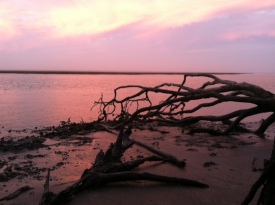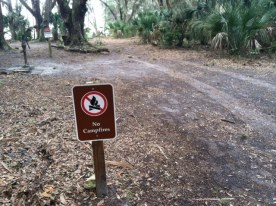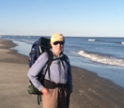You are currently browsing the tag archive for the ‘National Park Service’ tag.
Can We Still Keep Wilderness Wild?
by Louise Lasley
 Most of us probably believe we can correctly figure out fact from fiction, good from bad, and many other distinctions we make every day. But sometimes our perceptions are forged by subtle, if inadvertent, messages we receive. And before long the collective perspective becomes our culture with an almost unobservable change in what is believed to be right or good or necessary. This shift from original intent to accepted practices applies to our best-protected lands and threatens not only designated Wilderness, but the Wilderness Act, too.
Most of us probably believe we can correctly figure out fact from fiction, good from bad, and many other distinctions we make every day. But sometimes our perceptions are forged by subtle, if inadvertent, messages we receive. And before long the collective perspective becomes our culture with an almost unobservable change in what is believed to be right or good or necessary. This shift from original intent to accepted practices applies to our best-protected lands and threatens not only designated Wilderness, but the Wilderness Act, too.
I recently received information on an upcoming wilderness festival, and the first thing that caught my attention was the phrase: “management is a necessary part of our interaction with this resource” (meaning Wilderness). I count this as one of those subtle messages that tend to shift behavior. To manage something is a dynamic, manipulative action that implies human intervention and control. The responsibility of the four federal agencies that oversee Wilderness is to administer these lands using a hands-off approach rather than manage them. Congress and the American people have set aside Wilderness to allow nature to call the shots.
The Wilderness Act defines Wilderness as, “…an area where the earth and its community of life are untrammeled by man, where man himself is a visitor who does not remain.” Howard Zahniser explained in a 1957 speech the intended meaning of “untrammeled” as “free, unbound, unhampered, unchecked, having the freedom of the wilderness.”
Stewart Brandborg worked closely with Zahniser on the Wilderness Act, and then served as executive director of the Wilderness Society for 12 years after the law’s 1964 passage. These two roles created millions of acres of designated Wilderness. The late Bill Worf, a former Forest Service (FS) supervisor and fierce advocate for Wilderness, was part of a small group tasked with writing the FS regulations for the Wilderness Act. For years these two men were the backbone of Wilderness Watch, the only national organization working exclusively to assure that Wilderness is administered according to the law. Neither would stray from their conviction that the Act does not allow for compromise nor should it be subject to individual interpretation.
I can’t tell you when the shift from the original intent for stewardship of these lands began, but it has been moving a lot. The other night at dinner Stewart Brandborg said that the next presentation regarding Wilderness should be titled: “It’s all Screwed Up.” Here are a few examples of how the law is being disregarded:
- A private company used a helicopter to haul materials to repair the Fred Burr High Lake dam in the Montana portion of the Selway-Bitterroot Wilderness, even though in the past materials were carried in by packstock or found onsite.
- A proposed road would cut through the Izembek Wilderness in Alaska.
- In the Boundary Waters Canoe Area Wilderness in Minnesota, commercial towboat traffic has increased significantly instead of maintaining levels existing at the time of designation.
- There is a proposal to considerably expand the Fish Lake airstrip in the Selway-Bitterroot Wilderness in Idaho.
- In the Emigrant Wilderness in California, buildings have been rebuilt and commercial packstations exceed historical numbers.
- Commercial shellfishing is occurring in the Monomoy Wilderness in Massachusetts.
- 450 Helicopter landings have been proposed for bighorn management in Wildernesses in Arizona.
- Motorized cattle herding has been proposed in Wildernesses in the Owyhee region of Idaho.
- Water developments have been built in the Kofa Wilderness in Arizona, using construction equipment and helicopters.
- Unnecessary structures have been restored and rebuilt in the Olympic Wilderness in Washington.
- And on and on…
Such illegal actions were probably considered acceptable by the agencies, weren’t that much different than some earlier action, or would help with an issue unrelated to Wilderness. Or as my friend Howie says, “They have landscape amnesia.” In other words, they’ve forgotten what Wilderness is supposed to be. All illegal actions are damaging to Wilderness, but cumulatively they amount to a “death by a thousand cuts,” with incremental changes sometimes only obvious over longer periods of time.
How did we get to this place? Who is responsible? Often, agency employees notify Wilderness Watch of violations occurring in Wilderness. The most abused part of the Wilderness Act is the administrative exception in section 4(c), which allows the minimal action necessary to administer the Act. It was intended to apply to those exceedingly rare instances where motorized equipment, motor vehicles, aircraft, structures or installations are truly necessary and constitute the absolute minimum required to preserve Wilderness. Instead, the agencies increasingly invoke the exception whenever it is convenient or to promote recreation or one of the other uses of Wilderness. Unfortunately, many of these violations provide the jumping-off step for the next, bigger illegal action.
The U.S. Forest Service, the National Park Service, the Bureau of Land Management and the U.S. Fish and Wildlife Service have a long history of resisting the Wilderness Act. But it is not just the agencies that have dropped the ball. Congress has failed in its oversight of the agencies and its review of the state of the Wilderness system. A 1989 Government Accounting Office (GAO) report requested by the House Subcommittee on National Parks and Public Lands found that the Forest Service was “devoting only minimal attention to wilderness,” but nothing came of the report’s recommendations to prevent further degradation of Wilderness. In 1995, Congress passed the Paperwork Reduction Act, which rescinded a provision of the Wilderness Act that required the agencies to submit substantive annual reports to Congress on the state of the Wilderness system. And in perhaps the most alarming assessment of the Wilderness system, a 2001 report by the Pinchot Institute for Conservation warned, “The four wilderness agencies and their leaders must make a strong commitment to wilderness stewardship before the Wilderness System is lost.” Yet neither Congress nor the agencies have made any meaningful actions to address the recommendations of this in-depth, comprehensive report. It is now largely forgotten.
Current stewardship oversight, or lack thereof, is only part of the degradation of Wilderness by Congress. Congress is proposing bills as damaging to Wilderness as the violations the agencies are carrying out—and maybe more so. Bills designating Wilderness in the past were clear and simple and adhered to the Act. Increasingly, wilderness bills include exceptions not in the Act, have language that undercuts the Act, or add damaging non-conformities to both existing and proposed Wildernesses. The current Congress includes 51 such bills. , Many of the proposed bills are supported by the larger conservation organizations, who, because of their size, proximity to DC, and their budgets, have usurped negotiations from local organizations who are working to designate additional Wilderness. These larger organizations who claim that compromise is necessary to gain more public support, along with Congress, are making the Wilderness Act into something other than what was envisioned during its long and inclusive passage into law.
So whose responsibility is it to ensure that Wilderness retains the character that makes it wild, that ours and future generations are able to experience the wild, and that accountability for wilderness is acknowledged and accepted? I believe this responsibility belongs to Congress, to the four administering agencies, and finally to us—the “public”, the folks who know the wilderness lands around them, cherish their unique and special qualities, and are grateful for what Wildernesses don’t have: those activities that would make a Wilderness just the same as any other place. The question remains, can we still keep Wilderness wild in the face of so many challenges to the Act’s original intent?
Louise Lasley’s (president of Wilderness Watch) pursuit of backcountry activities produced a strong advocacy for wilderness and the values we find in wild places. She has worked for years to protect those values around the globe and particularly within the Greater Yellowstone Ecosystem. Work on public lands and wildlife issues for the Jackson Hole Conservation Alliance, Northern Rockies Conservation Cooperative, the Wildlife Conservation Society, Africa Rainforest and River Conservation, and as a naturalist for the Bridger-Teton National Forest and Spring Creek Resort has been fundamental to her new endeavor to look at local issues as she travels around the West. After living in Jackson Hole for 30 years, Louise began the life of a gypsy this year looking for a someplace to call home. She hopes that her knowledge and experience of public lands and wildlife concerns will help in her transition to a new community.
by Jerome Walker
 In February, the weather is usually perfect on Georgia’s coastal islands. That’s one of the reasons why America’s wealthiest men formed the exclusive Jekyll Island Club during the late 1800’s and turned that island into a Gilded Age playground. Every winter they repaired to their “cottages” on Jekyll to hunt, fish, play golf and tennis, sail, and otherwise divert themselves. It’s rumored that poor Thomas Carnegie wanted to join the club, but because he and his brother Andrew came to this country as penniless teenagers from Scotland, they were supposedly turned away. Whether this story is true or not, in 1884 Thomas Carnegie purchased most of Cumberland Island, just south of Jekyll Island. He and his wife Lucy then proceeded to build a complex of lavish mansions there. Today, 17 mile-long Cumberland Island, larger than Manhattan Island, is a National Seashore, administered by the National Park Service. Along with places like Yellowstone and the Grand Canyon, it’s been designated a World Heritage Center by the United Nations for its unique natural beauty. Roughly the northern half of the island is a federally designated Wilderness.
In February, the weather is usually perfect on Georgia’s coastal islands. That’s one of the reasons why America’s wealthiest men formed the exclusive Jekyll Island Club during the late 1800’s and turned that island into a Gilded Age playground. Every winter they repaired to their “cottages” on Jekyll to hunt, fish, play golf and tennis, sail, and otherwise divert themselves. It’s rumored that poor Thomas Carnegie wanted to join the club, but because he and his brother Andrew came to this country as penniless teenagers from Scotland, they were supposedly turned away. Whether this story is true or not, in 1884 Thomas Carnegie purchased most of Cumberland Island, just south of Jekyll Island. He and his wife Lucy then proceeded to build a complex of lavish mansions there. Today, 17 mile-long Cumberland Island, larger than Manhattan Island, is a National Seashore, administered by the National Park Service. Along with places like Yellowstone and the Grand Canyon, it’s been designated a World Heritage Center by the United Nations for its unique natural beauty. Roughly the northern half of the island is a federally designated Wilderness.
Since Cumberland Island now belongs to the American public, who purchased it from the private owners, in early February of last year my wife and I decided to check on our property by making a three day-back-pack. It was her first visit to the island, and we especially wanted to visit Cumberland Island Wilderness, and also visit Carol Ruckdeschel, a renowned biologist who lives on the island. For decades, Carol has fiercely protected both the island and the endangered sea turtles who nest on its beaches every summer. Carol is part of the fascinating history of Cumberland Island, and has been written about by a number of writers, including John McPhee. The most recent, and probably best account of her efforts to keep Cumberland wild, is Will Harlan’s book “Untamed: The Wildest Woman in America and the Fight for Cumberland Island,” which was published by Grove Press this past May.
After spending the night in St. Marys, a sleepy fishing village on the southeast tip of Georgia’s coast, we boarded the early morning Park Service ferry for the 45 minute ride to the island. Pelicans and gulls flew overhead and dolphins played in the ferry’s bow wave. After a brief orientation at Sea Camp Ranger Station — which used to be developer Charles Fraser’s headquarters when he had plans to turn the island into another Hilton Head — we started walking north towards the Wilderness. Along the way we passed near Greyfield, one of the mansions built as wedding gifts for Thomas and Lucy Carnegie’s children. Now it’s an inn run by some of the Carnegie descendants.
 A little over a decade ago, on a backpack with friends, I witnessed the Park Service driving a pickup truck through the wilderness area, and later saw a truck load of guests staying at Greyfield Inn being taken on a motorized commercial tour through the Wilderness. Soon thereafter, the Park Service, with the blessing of The Wilderness Society and National Parks Conservation Association, began conducting its own motorized visitor tours using 15-passsenger vans. When this was reported to Wilderness Watch’s founder Bill Worf, he was incredulous and came to Georgia himself to check it out. Later, in 2004, Wilderness Watch brought suit against the Park Service and won in the Eleventh Circuit U.S. Court of Appeals. A three judge panel ruled unanimously that of course driving in Wilderness was illegal. Unfortunately, this victory was short-lived, as the local Republican Congressman, Jack Kingston, quietly tacked a rider onto an omnibus spending bill in Congress later that same year. His rider removed the unpaved single lane main road that runs the length of the island and also the entire beach from the Wilderness. This was the first time, and hopefully the last, that Wilderness had ever been removed from the National Wilderness Preservation System without public input.
A little over a decade ago, on a backpack with friends, I witnessed the Park Service driving a pickup truck through the wilderness area, and later saw a truck load of guests staying at Greyfield Inn being taken on a motorized commercial tour through the Wilderness. Soon thereafter, the Park Service, with the blessing of The Wilderness Society and National Parks Conservation Association, began conducting its own motorized visitor tours using 15-passsenger vans. When this was reported to Wilderness Watch’s founder Bill Worf, he was incredulous and came to Georgia himself to check it out. Later, in 2004, Wilderness Watch brought suit against the Park Service and won in the Eleventh Circuit U.S. Court of Appeals. A three judge panel ruled unanimously that of course driving in Wilderness was illegal. Unfortunately, this victory was short-lived, as the local Republican Congressman, Jack Kingston, quietly tacked a rider onto an omnibus spending bill in Congress later that same year. His rider removed the unpaved single lane main road that runs the length of the island and also the entire beach from the Wilderness. This was the first time, and hopefully the last, that Wilderness had ever been removed from the National Wilderness Preservation System without public input.
Later that day, we passed another luxurious Carnegie mansion, Plum Orchard, which the Park Service has renovated at considerable expense for daily tours. At 25,000 square feet with countless bedrooms, an indoor pool and squash court, a huge formal dining room, a “gun room” for the men, and an enormous staff of servants, it was a wedding gift to Thomas and Lucy’s son George, who enjoyed it only for a few months each year. Finally, we reached the wilderness boundary and spent our first night in Yankee Paradise, one of three designated wilderness camping areas. The next day we hiked under huge live-oak trees dripping Spanish moss to our next campsite at Brickhill Bluff, which overlooks the marshes between the island and the mainland. After setting up our tent, we continued hiking to the north end of the island. This is a small area beyond the wilderness boundary shared by Carol’s modest cabin, the historic one room First African Baptist Church, established in 1893, and a private complex owned by the Candlers, heirs of the inventor of Coca-Cola. We spent a very pleasant afternoon sitting on Carol’s porch, marveling at the pet animals, including several buzzards, that live there with Carol, and talking about the challenges of keeping the island protected, which are explained in an excellent website that Carol writes, http://www.wildcumberland.org.
 Jerome Walker’s introduction to Wilderness Watch and Wilderness began when his late wife, Melissa, author of Living on Wilderness Time, served 10 years on WW’s board, including a term as vice president. A retired neurologist who specialized in groundbreaking headache research and treatment, Jerome has concentrated on wilderness photography for the last two decades. He has photographed wild country from Alaska to Florida, traveling on foot and by canoe. Jerome’s images have been displayed in galleries and currently are in private and corporate collections throughout the country. They have been used in books, newsletters, calendars and are on his website (jeromewalkerphotography.com). His time in Wilderness has led him to recognize its fragility and has motivated his work to protect it. He lives in Missoula, MT.
Jerome Walker’s introduction to Wilderness Watch and Wilderness began when his late wife, Melissa, author of Living on Wilderness Time, served 10 years on WW’s board, including a term as vice president. A retired neurologist who specialized in groundbreaking headache research and treatment, Jerome has concentrated on wilderness photography for the last two decades. He has photographed wild country from Alaska to Florida, traveling on foot and by canoe. Jerome’s images have been displayed in galleries and currently are in private and corporate collections throughout the country. They have been used in books, newsletters, calendars and are on his website (jeromewalkerphotography.com). His time in Wilderness has led him to recognize its fragility and has motivated his work to protect it. He lives in Missoula, MT.
by Kevin Proescholdt
 I recently came across an on-line forum asking whether “snow kiting” is allowed in Wilderness. While snow kiting in Wilderness might still be a rather rare activity, the question bears quite heavily on a variety of activities and the future of the National Wilderness Preservation System.
I recently came across an on-line forum asking whether “snow kiting” is allowed in Wilderness. While snow kiting in Wilderness might still be a rather rare activity, the question bears quite heavily on a variety of activities and the future of the National Wilderness Preservation System.
For those unfamiliar with the sport, snow kiting is an offshoot of kiteboarding (a water sport), but conducted on land and on snow. Like kiteboarders, snow kiters use large inflatable kites – some are similar to parasails – that allow the wind to pull them along or to jump and glide in the air for seconds at a time. Kite lines run to a snow kiter’s harness and handle, which are used to maneuver the kite. Though many snow kiters use snowboards, some telemark and alpine skiers also use kites as part of their sport.
Snow kiting in units of the wilderness system seems to have increased in recent years. But I believe snow kiting violates the Wilderness Act, even though the federal agencies have been slow in writing specific rules spelling out such a ban. I hope that soon, before this use becomes too entrenched in units of the wilderness system, all four agencies will ban snow kiting in Wilderness for two main reasons.
First, snow kiting violates the Wilderness Act, most notably its ban on mechanical transport in Wilderness. U.S. Forest Service wilderness policy comes close to articulating a ban on snow kiting, by prohibiting (among other banned mechanical transport) hang gliders and parachutes, which are similar to snow kiting:
Forest Service Manual 2320.5
Mechanical Transport. Any contrivance for moving people or material in or over land, water, or air, having moving parts, that provides a mechanical advantage to the user, and that is powered by a living or nonliving power source. This includes, but is not limited to, sailboats, hang gliders, parachutes, bicycles, game carriers, carts, and wagons.
At least some of these specific prohibitions have held up in the courts. A federal court upheld a Forest Service ban on sailboats on wilderness lakes, for example, in one of a series of court cases involving the Sylvania Wilderness in the Upper Peninsula of Michigan. The 6th Circuit Court of Appeals wrote in this case, “Certainly, Congress could rationally conclude that certain forms of mechanical transport, including sailboats and houseboats, should be excluded from the Sylvania Wilderness in order to preserve the ‘wilderness character’ of the property.”
The National Park Service also appears to have prohibited snow kiting in Wilderness, though under its regulations that govern aircraft (snow kiting meets its definition of aircraft in the Code of Federal Regulations) and “aerial delivery,” and not under its regulations prohibiting mechanical transport in Wilderness. As a result, the Park Service has prohibited snow kiting in Glacier National Park’s Recommended Wilderness as well as in other national park Wildernesses.
In addition to violating the ban on mechanized travel, snow kiting runs against the grain of the types of recreation the Wilderness Act sought to provide. The law defines Wilderness in part as providing “a primitive and unconfined type of recreation….” Snow kiting is clearly not this type of primitive recreation envisioned by the Wilderness Act.
Second, beyond the legal violations, snow kiting should be banned in Wilderness because the activity makes Wildernesses less wild. This is not about snow kiting’s physical impacts on Wilderness, but about our relationship to Wilderness. Snow kiting is a modern transportation method, not one envisioned by the founders of the Wilderness Act or the ideals behind it. It is not travel by primitive means. It ignores the humility and restraint that Wilderness Act author Howard Zahniser urged us to use in our relationship to Wilderness.
Wilderness is in part about preserving and experiencing these places from an earlier time and an earlier pace of travel, such as by foot, horseback, or canoe. According to the Wilderness Act, designated Wildernesses are to be “in contrast with those areas where man and his works dominate the landscape….” If snow kiting and other yet-to-be-created transportation means are allowed in Wilderness, that contrast will be increasingly diminished and indistinct, and Wilderness will cease to be that special place set apart from modern civilization. I believe that we must stand up for that distinction or we open the door to untold and unforeseen levels of non-human- or non-animal-powered transportation in Wilderness, making Wilderness little different from the rest of our human-dominated landscape.
I understand the concern expressed by some that any restrictions short of an outright ban on all mechanical devices (including, for example, a ski binding) would be somewhat arbitrary. But it seems that the most reasonable, protective, and defensible rule is one rooted in the methods of travel in common use at the time the Wilderness Act was passed. This is the approach a federal court took when several members of the Chippewa (also called Ojibwe or Anishinaabe) tribe challenged the prohibition on snowmobile use while exercising their treaty rights to fish in the Boundary Waters Canoe Area Wilderness in Minnesota. The court relied on the fact that Band members traditionally accessed the area by canoe or on foot at the time of the 1854 treaty, and therefore the Wilderness Act’s ban on modern snowmobiles didn’t constitute an infringement on treaty rights.
If we don’t keep wilderness protections anchored to something solid like the primitive modes of travel contemplated in the law, what’s to protect Wilderness from any whimsical fad, recreational pursuit, or technological advance that comes its way?
Kevin Proescholdt is conservation director (and former board president) for Wilderness Watch. He has written extensively on the Boundary Waters, and wilderness policy and history.

You must be logged in to post a comment.